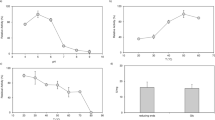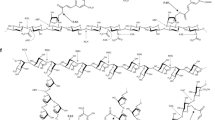Abstract
Fungal glucuronoyl esterases (FGEs) catalyze cleavage of the ester bond connecting a lignin alcohol to the xylan-bound 4-O-methyl-d-glucuronic acid of glucuronoxylans. Thus, FGEs are capable of degrading lignin-carbohydrate complexes and have potential for biotechnological applications toward woody biomass utilization. Therefore, identification and characterization of new FGEs are of critical importance. Firstly, in this study, we built a phylogenetic tree from almost 400 putative FGEs obtained on BLAST analysis and defined six main clades. In the phylogenetic tree, all the putative FGEs of ascomycetes cluster in clades I to IV, and most of the putative FGEs of basidiomycetes (B-FGEs) cluster in clades V to VI. Interestingly, several B-FGEs were found to cluster in clade II; most FGEs of clade II were found to have higher theoretical isoelectric points than those in the other five clades. To gain an insight into the putative FGEs in the clades that have not been characterized yet, we chose the FGEs of Ceriporiopsis subvermispora (CsGE) and Pleurotus eryngii (PeGE), which belong to clades V and II, respectively. The catalytic domains of both CsGE and PeGE were successfully expressed using Pichia pastoris, and then purified. Benzyl glucuronic acid was used as a substrate to confirm the activities of the CsGE and PeGE, and the hydrolyzed product, glucuronic acid, was quantified spectrophotometrically. Both CsGE and PeGE clearly exhibited the esterase activity. Additionally, we demonstrated that PeGE exhibits high tolerance toward several denaturing agents, which may make it a potentially more applicable enzyme.





Similar content being viewed by others
References
Agger JW, Busk PK, Pilgaard B, Meyer AS, Lange L (2017) A new functional classification of glucuronoyl esterases by peptide pattern recognition. Front Microbiol 8:1–8. https://doi.org/10.3389/fmicb.2017.00309
Arnling Bååth J, Giummarella N, Klaubauf S, Lawoko M, Olsson L (2016) A glucuronoyl esterase from Acremonium alcalophilum cleaves native lignin-carbohydrate ester bonds. FEBS Lett 590:2611–2618. https://doi.org/10.1002/1873-3468.12290
Charavgi MD, Dimarogona M, Topakas E, Christakopoulos P, Chrysina ED (2013) The structure of a novel glucuronoyl esterase from Myceliophthora thermophila gives new insights into its role as a potential biocatalyst. Acta Crystallogr Sect D Biol Crystallogr 69:63–73. https://doi.org/10.1107/S0907444912042400
d’Errico C, Jørgensen JO, Krogh KBRM, Spodsberg N, Madsen R, Monrad RN (2015) Enzymatic degradation of lignin-carbohydrate complexes (LCCs): model studies using a fungal glucuronoyl esterase from Cerrena unicolor. Biotechnol Bioeng 112:914–922. https://doi.org/10.1002/bit.25508
d’Errico C, Börjesson J, Ding H, Krogh KBRM, Spodsberg N, Madsen R, Monrad RN (2016) Improved biomass degradation using fungal glucuronoyl-esterases-hydrolysis of natural corn fiber substrate. J Biotechnol 219:117–123. https://doi.org/10.1016/j.jbiotec.2015.12.024
Ďuranová M, Špániková S, Wösten HA, Biely P, De Vries RP (2009a) Two glucuronoyl esterases of Phanerochaete chrysosporium. Arch Microbiol 191:133–140. https://doi.org/10.1007/s00203-008-0434-y
Ďuranová M, Hirsch J, Kolenová K, Biley P (2009b) Fungal glucuronoyl esterases and substrate uronic acid recognition. Biosci Biotechnol Biochem 73:2483–2487. https://doi.org/10.1271/bbb.90486
Gasteiger E, Hoogland C, Gattiker A, Duvaud S, Wilkins MR, Appel RD, Bairoch A (2005) Protein identification and analysis tools on the ExPASy server. In: Walker JM (ed) The proteomics protocols handbook. Humana Press, Totowa, NJ, pp 571–607
Hori C, Gaskell J, Igarashi K, Kersten P, Mozuch M, Samejima M, Cullen D (2014) Temporal alterations in the secretome of the selective ligninolytic fungus Ceriporiopsis subvermispora during growth on aspen wood reveal this organism’s strategy for degrading lignocellulose. Appl Environ Microbiol 80:2062–2070. https://doi.org/10.1128/AEM.03652-13
Hüttner S, Klaubauf S, de Vries RP, Olsson L (2017) Characterisation of three fungal glucuronoyl esterases on glucuronic acid ester model compounds. Appl Microbiol Biotechnol 101:5301–5311. https://doi.org/10.1007/s00253-017-8266-9
Huynh HH, Arioka M (2016) Functional expression and characterization of a glucuronoyl esterase from the fungus Neurospora crassa: identification of novel consensus sequences containing the catalytic triad. J Gen Appl Microbiol 224:1–8. https://doi.org/10.2323/jgam.2016.03.004
Huynh HH, Ishii N, Matsuo I, Arioka M (2018) A novel glucuronoyl esterase from Aspergillus fumigatus – the role of conserved Lys residue in the preference for 4-O-methyl glucuronoyl esters. Appl Microbiol Biotechnol 102:2191–2201. https://doi.org/10.1007/s00253-018-8739-5
Jones DT, Taylor WR, Thornton JM (1992) The rapid generation of mutation data matrices from protein sequences. Bioinformatics 8:275–282. https://doi.org/10.1093/bioinformatics/8.3.275
Li XL, Špániková S, de Vries RP, Biely P (2007) Identification of genes encoding microbial glucuronoyl esterases. FEBS Lett 581:4029–4035. https://doi.org/10.1016/j.febslet.2007.07.041
Mosbech C, Holck J, Meyer AS, Agger JW (2018) The natural catalytic function of CuGE glucuronoyl esterase in hydrolysis of genuine lignin-carbohydrate complexes from birch. Biotechnology for Biofuels 11:1–9. https://doi.org/10.1186/s13068-018-1075-2
Petersen TN, Brunak S, von Heijne G, Nielsen H (2011) SignalP 4.0: discriminating signal peptides from transmembrane regions. Nat Methods 8:785–786
Pokkuluri PR, Duke NEC, Wood SJ, Cotta MA, Li XL, Biely P, Schiffer M (2011) Structure of the catalytic domain of glucuronoyl esterase Cip2 from Hypocrea jecorina. Proteins 79:2588–2592. https://doi.org/10.1002/prot.23088
Špániková S, Biely P (2006) Glucuronoyl esterase – novel carbohydrate esterase produced by Schizophyllum commune. FEBS Lett 580:4597–4601. https://doi.org/10.1016/j.febslet.2006.07.033
Špániková S, Poláková M, Joniak D, Hirsch J, Biely P (2007) Synthetic esters recognized by glucuronoyl esterase from Schizophyllum commune. Arch Microbiol 188:185–189. https://doi.org/10.1007/s00203-007-0241-x
Sunner H, Charavgi MD, Olsson L, Topakas E, Christakopoulos P (2015) Glucuronoyl esterase screening and characterization assays utilizing commercially available benzyl glucuronic acid ester. Molecules 20:17807–17817. https://doi.org/10.3390/molecules201017807
Topakas E, Moukouli M, Dimarogona M, Vafiadi C, Christakopoulos P (2010) Functional expression of a thermophilic glucuronoyl esterase from Sporotrichum thermophile: identification of the nucleophilic serine. Appl Microbiol Biotechnol 87:1765–1772. https://doi.org/10.1007/s00253-010-2655-7
Vagenende V, Yap MGS, Trout BL (2009) Mechanisms of protein stabilization and prevention of protein aggregation by glycerol. Biochemistry 48:11084–11096. https://doi.org/10.1021/bi900649t
Xie C, Yan L, Gong W, Zhu Z, Tan S, Chen D, Hu Z, Peng Y (2016) Effects of different substrates on lignocellulosic enzyme expression, enzyme activity, substrate utilization and biological efficiency of Pleurotus eryngii. Cell Physiol Biochem 39:1479–1494
Yin Y, Mao X, Yang J, Chen X, Mao F, Xu Y (2012) dbCAN: a web resource for automated carbohydrate-active enzyme annotation. Nucleic Acids Res 40:W445–W451. https://doi.org/10.1093/nar/gks479
Funding
This work was supported by JSPS KAKENHI grants to M.K. (#18H04550 and #18K19397) and to T.N. (#17K07307 and #17H05878), JST/ALCA, the Joint Usage/Research Program on Zero-Emission Energy Research (ZE30A-36), and the Collaboration Program of the Laboratory for Complex Energy Processes.
Author information
Authors and Affiliations
Corresponding authors
Ethics declarations
Conflict of interest
The authors declare that they have no conflicts of interest.
Ethical approval
This article does not contain any studies with human participants or animals performed by any of the authors.
Electronic supplementary material
ESM 1
(PDF 5094 kb)
Rights and permissions
About this article
Cite this article
Lin, MI., Hiyama, A., Kondo, K. et al. Classification of fungal glucuronoyl esterases (FGEs) and characterization of two new FGEs from Ceriporiopsis subvermispora and Pleurotus eryngii. Appl Microbiol Biotechnol 102, 9635–9645 (2018). https://doi.org/10.1007/s00253-018-9318-5
Received:
Revised:
Accepted:
Published:
Issue Date:
DOI: https://doi.org/10.1007/s00253-018-9318-5




